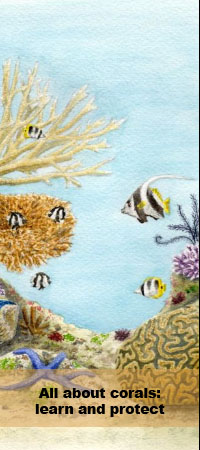|
The physical structure of a coral reef is built by reef-building polyps. As they secrete calcium carbonate skeletons, they create a complex three dimensional framework upon which an abundance of coral species and other marine plants and animals may live. Approximately 25% of all marine life on the planet can be found in corals reefs. This includes around 2 million species of fish, crustaceans, molluscs, sponges, sea cucumbers and seaweeds. Together, these plants and animals form the coral reef ecosystem. As well as supporting marine biodiversity, reef ecosystems provide a number of ecological services and goods to human populations on a local, regional, and national level as they play an important role in coastline and habitat protection, nitrogen fixing, sand supply, climate records, fisheries, medicine, recreation and tourism.
The ecological functions and economic value of coral reef ecosystems
Coral reefs: Protectors of the shoreline, mangrove forests and seagrass beds.
Coral reef frameworks can serve as physical buffers for ocean waves and currents. As waves pass over a reef structure, their energy can be reduced by 75-95% which can lessen their impact as they reach the shore. This not only protects the coastline from erosion but prevents damage to and/or loss of seagrass beds, mangrove forests, coastal settlements and infrastructure. Although the buffering capacity of coral reefs is generally less effective against large storm waves, coral reefs can, in some circumstances, provide some protection again tsunami waves. The extent of protection gained from the reef is, however, dependant on a number of other factors including the reef size and structure. Today, approximately 150,000 km of coastline across 100 countries and territories receive some protection from wave energy. The value of shoreline protection from coral reefs, based on the anticipated loss of property, avoided damages (where reefs have been perceived to reduce wave inundation) and the cost of building artificial shoreline protection structures (to substitute a reef) was US$10.7 billion in 2010.
Coral reefs: A source of nitrogen fixers
Coral reefs are generally found in low nutrient environments. Despite this, they are able to support a large number of marine organisms all of which require nutrients for development, growth and survival. Although molecular nitrogen (N2), a type of macronutrient, is abundant in the atmosphere and ocean, few marine organisms can utilise nitrogen in this form. Coral associated bacteria, such as the photosynthetic cyanobacteria, are one of the few marine organisms that are able to take molecular nitrogen (N2) from the water and convert or ‘fix’ it to produce more usable products such as ammonia (NH3), ammonium (NH4+) and nitrate (NO3-) as well as the intermediate by products nitrous oxide (N2O) and nitrite (NO2-). Once converted, these ‘fixed’ nitrogen products can be utilised by marine plants that are equipped with special enzymes that reduce the nitrogen even further. These plants also provide a source of food for herbivorous feeders which allows nitrogen to enter the food chain. Coral associated bacteria therefore play a vital role in the marine nitrogen cycle upon which other marine organisms depend.
Coral reefs: Suppliers of sand
Coral reefs play an important role in the supply of sediments or sands to beaches. As marine organisms such as fish, snails, sponges, worms and urchins feed and bore into a reef framework (see threats), they remove and/or excrete small calcium carbonate sediments. These sediments can become suspended in the ocean water where they may then be carried and deposited ashore by waves. Coral derived sands are white in colour and have since become associated with tropical beaches although in many cases coral reefs not the sole supplier of sand to beaches as they can also receive sediments generated on land.
Coral reefs: Providers of climate records
The skeletal composition of some coral species can provide historical accounts of local and regional environmental conditions. The width and density of calcium carbonate skeletons secreted by a polyp is influenced by the environmental conditions of the ambient seawater e.g., water temperature, hydrologic balance (evaporation, precipitation, runoff), and ocean circulation. As skeletons are deposited over time, they create high and low density bands which can be counted to determine the age of a coral like growth rings on a tree. Based on the densities of these rings, scientists can determine the environmental conditions at the time of secretion which can then provide a climate record spanning a considerable period of time. This climate information is now being used by scientists, along with more recent climate records, as a tool for examining the predicted impacts of environmental disturbances associated with global climate change.
Coral reefs: Supporters of subsistence and commercial fisheries
Coral reefs provide essential shelter, feeding, nursery and spawning grounds for a number of marine organisms including reef-associated fish. Today, fish are considered to be one of the most important components of the reef as they support subsistence and commercial fishing activities and provide a valuable source of protein in people’s diet. Approximately 5-15 tonnes of fish and seafood products can be yielded per km2 of reef on a healthy reef system. On average, reef-associated fish catch can also account for one-quarter of the total fish catch in developing countries. The removal and processing of these foods for markets provides enormous opportunities for employment on fishing vessels as well as in factories and in local, national and global markets. In developing countries, fisheries activities play a particularly important role as they contribute towards poverty alleviation by providing food, income and employment. Today, the total number of reef fishers in each of Indonesia, Philippines, India, Vietnam, and China are estimated to be between 100,000 and more than one million. In Southeast Asia, coral reef fisheries alone are estimated to yield US$ 2.4 billion annually while the annual net benefits from coral reef fisheries worldwide in 2010 were valued at an estimated US$ 6.8 billion.
Coral reefs: A source of recreation and tourism
Coral reefs provide opportunities for a number of recreational activities such as swimming, snorkelling and SCUBA-diving and can attract visitors from across the globe. While some recreational activities may be undertaken privately, many require the support of local tour operators providing further livelihood opportunities for local populations. More than 100 countries and territories currently benefit from reef-associated tourism. In 2010, the global net benefits of reef tourism were valued at US$ 11.5 billion.
Coral reefs: A provider of medicines
Many marine organisms found on coral reefs are rich in chemical compounds known as marine natural products (MNPs). These MNPs are generally used by the organism as a means of protection against predators however pharmaceutical companies have since discovered that they can also be used in the production of human medicines. The soft coral Eleutherobia spp and encrusting Erythropodium caribaeorim coral have been used in the production of Eleutherobin, a potent cancer cell inhibitor, while the Caribbean sea squirt has been found to contain an anti-cancer agent that can be used in the in the treatment of ovarian cancer. Other medicines and treatments that have derived from marine organisms include AIDS inhibitors, anti-inflammatory and anti-coagulatants as well as use of coral bone grafts. Few economic valuations of MNPs are currently available, however a valuation model of anti-cancer drugs alone suggests that a 20% loss of coral reef biodiversity would equate to a market value loss of US$112 billion -1.14 trillion.
|
|
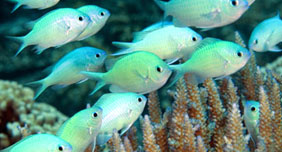
Around two million species are found in coral reefs. © Paddy Ryan
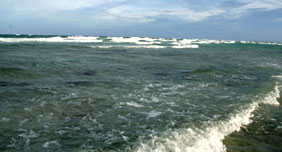
Coral reefs serve as physical buffers for ocean waves and currents. © Pierre Fidenci
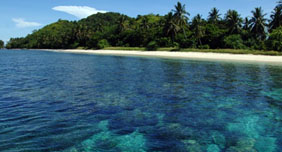
Coral reef protecting the seashore. © Pierre Fidenci
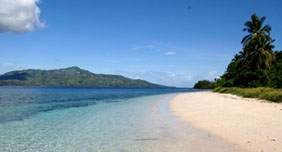
Coral reefs are sources of sand for some beaches. © Pierre Fidenci
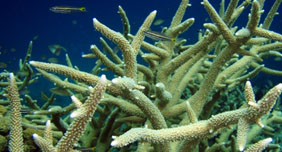
Coral reefs support an abundance of marine plants and animals. © Pierre Fidenci
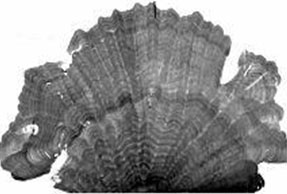
Some ancient corals, species such as massive Porites corals, can provide valuable climate records. (Picture adapted from http://wires.wiley.com/WileyCDA/WiresArticle/wisId-WCC39.html)
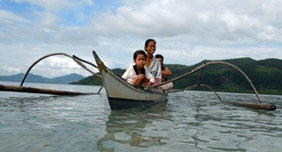
Coral reef fisheries provide essential protein in people’s diet. © Pierre Fidenci
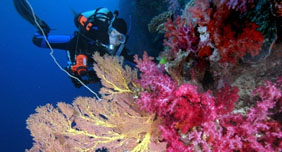
Coral reef tourism creates livelihood opportunities and revenues generated contribute to national economies. © Paddy Ryan
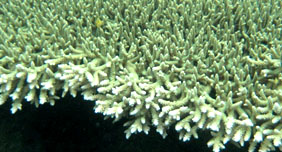
Coral can be used in production of medecines. © Pierre Fidenci
|

